Cash flow is apparently the most significant estimation of your organization’s financial health. All things considered, without cash close by you can’t pay your staff, restock product or grow your business.
With regards to estimating the strength of your cash flow, it’s insufficient to simply check your ledger balance. You’d increase substantially more understanding by running an essential cash-flow check. This cheat sheet of the key ideas will walk you through the process:
Cash-Flow Statement Basics
Cash flow is one of the three fundamental fiscal summaries, alongside your asset report and pay explanation. The asset report shows what your business possesses and owes, the pay proclamation shows whether you made a benefit or a misfortune throughout the last time frame (month, quarter, year, whichever timespan you pick) while the cash-flow articulation estimates whether your cash balance developed or shrank over the past period.
The way the cash-flow articulation does this is by including every one of your inflows, when cash comes in, and afterward subtracting all your cash outflows. On the off chance that the absolute figure is positive, you should have more cash close by than when the period began, while if it’s negative, you will have less.
Key Concepts for Cash-Flow Analysis
Your cash flow chart should record all the cash inflows and outflows every month and group them into three fundamental classifications:
Working expenses. This will be the greatest segment. It covers inflows like making sales and gathering installment on your records receivables/solicitations and every one of the outflows from maintaining your business (paying staff, lease, utilities, restocking stock, and so on.)
Venture expenses. This classification covers the buy and closeout of business resources inconsequential to your everyday activities. This could be an outflow since you purchased another structure or a cash increment since you sold an unused bit of gear.
Financing expenses. This spreads cash going in and out from business credits, speculators and for paying a profit to the entrepreneurs.
With this data, you can perceive any reason why your cash position changed. Suppose your parity developed by $50,000. In the event that you have more cash as a result of solid deals, that is clearly an indication of a sound business. Then again, if deals fell yet you have more cash since you applied for a line of credit, that is less promising. These are two altogether different circumstances, yet on the off chance that you just took a gander at your bank balance, you’d miss this data and hazard having your cash flow go off-track.
If you find your cash flow has in fact gone off track, there are solutions to get it back on track. One of these is invoice factoring, or accounts receivable financing. Selling your invoices to an invoice factoring company will benefit you with the cash up front to continue business as usual and allow growth. You will receive 85-90% up front from the invoices you sell. The factoring company will wait for your customers to pay and once they do, you will receive the balance less fees.
Invoice factoring is especially good for start-ups and entrepreneurs who may not have qualifying criteria for a bank loan. American Receivable has solutions for cash flow problems and works with a large variety of industries. Call us today!








